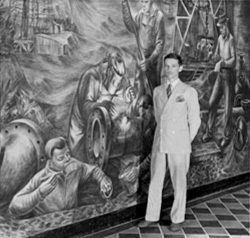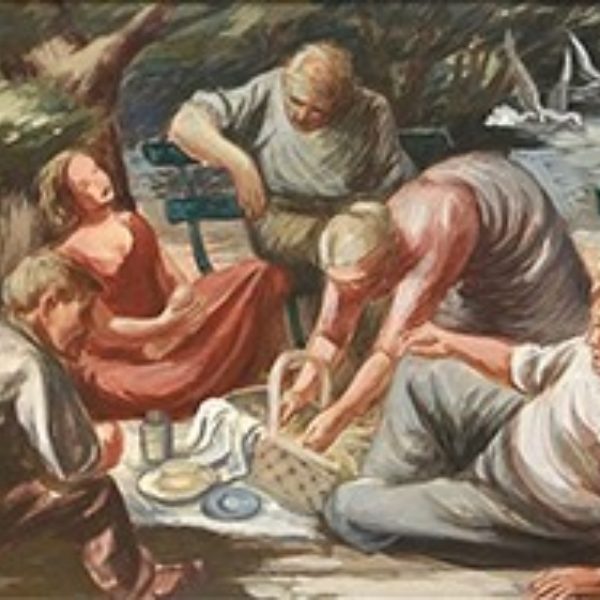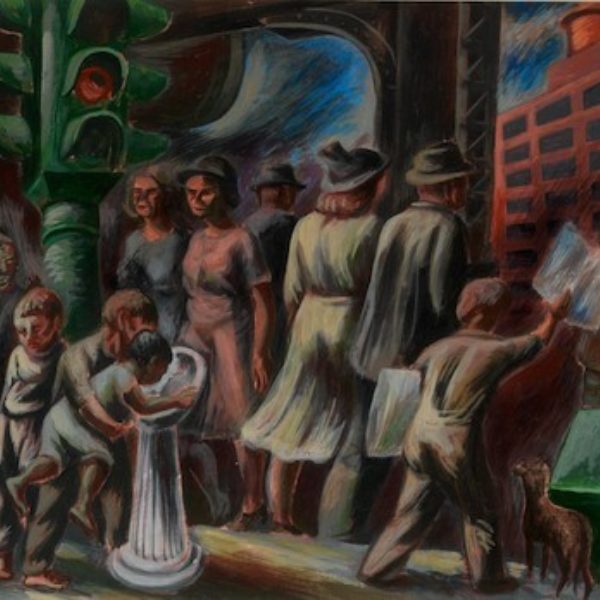
Edgar Britton
b. 1901, Kearney, NE - d. 1982, Denver, CO
Edgar Britton was born in Kearney, Nebraska, and studied at the University of Iowa and at the University of Kansas. He worked with Grant Wood in Cedar Rapids, Iowa, from 1920–24, and moved to Chicago in 1925, working on various architectural commissions until 1935. From 1935 to 1940 he completed numerous murals for the Illinois Art Project, mural and sculpture divisions, and served as technical director from 1940–41. He completed frescos for the Works Progress Administration at Lane Tech High School, Chicago; Highland Park High School, Highland Park, IL; and the University of Illinois Medical Center, to name a few. Commissioned by the Section of Painting and Sculpture, he also created murals for U.S. post offices in East Moline and Decatur, Illinois.
Britton was influenced by the social-realist style of the Mexican muralists including Diego Rivera, Jose Orozco, and David Siqueiros. His 1938 Mural Study typifies his approach, with its “simplified, weighty forms.” In it, he depicts an everyday urban scene taking place below the elevated train tracks. A small boy sells newspapers, an elderly man walks with a cane, and children drink from a water fountain amidst a crush of people walking in the street. The figures are pressed together, and their lack of facial details has been described as showing the dehumanization of city life during the Depression.
Mural designs often encapsulate sustained reflection on a subject, and Britton’s mural study—a gouache made in the 1930s, Untitled (Picnic in the park)—draws on the long tradition of depicting urbane leisure in a natural setting, as seen in Giorgione’s Pastoral Concert (c. 1509, Louvre, Paris—now attributed to Titian). Britton depicts a man on the bench, his right knee bent, playing a guitar, in the same pose of Giorgione’s figure strumming a lute. Britton may also have borrowed from Manet’s Déjeuner sur l’herbe (1862-63; Musée d’Orsay, Paris) for his central figure, who reclines on his left arm, his right extended above, echoing Manet’s canonical picnicking bourgeois. These pastoral excursions offer escape and relief from life in the city, and in Britton’s case, from the trials of the Depression era—as depicted in his 1938 mural study.
Known primarily for his murals, Britton also painted oils and watercolors and sculpted in bronze. He moved to Colorado in 1942 after a doctor recommended a drier climate because of his tuberculosis. He stayed there the remainder of his life, teaching at the Colorado Springs Fine Art Center until 1951 and focusing primarily on creating sculpture. From 1967 to 1971, he was a member of the Fine Arts Commission of Denver, and he served as president of the Artists Equity in Colorado Springs.
Lisa Meyerowitz
References
Becker, Heather. Art for the People: The Rediscovery and Preservation of Progressive- and WPA-Era Murals in the Chicago Public Schools, 1904–1943. San Francisco: Chronicle Books, 2002.
Britton, Edgar. Pamphlet file P-01093. Ryerson Library. Art Institute of Chicago. [2 items]
Galpin, Amy, and Susan Weininger. “Edgar Britton.” In Elizabeth Kennedy, ed. Chicago Modern, 1893–1945: Pursuit of the New, 95. Exh. cat. Chicago: Terra Foundation for the Arts, 2004.
Yochim, Louise Dunn. Role and Impact: The Chicago Society of Artists, 224. Chicago: Chicago Society of Artists, 1979.
The Depression Era Art Projects in Illinois, http://www.lib.niu.edu/2000/ihsp0004.html.
Artist Image: Edgar Britton standing next to his mural for the Interior Dept., Washington, D.C., ca. 1930 / unidentified photographer. Forbes Watson papers, Archives of American Art, Smithsonian Institution.

